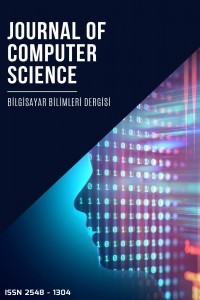Pupil Center Localization Based on Mini U-Net
U-Net, mini U-Net, Göz bebeği merkezi yerelleştirmesi, gi4e
Pupil Center Localization Based on Mini U-Net
U-Net, mini U-Net, pupil center localization, gi4e.,
___
- Cai H, Liu B, Ju Z, Thill S, Belpaeme T, Vanderborght B, Liu H. (2018) Accurate Eye Center Localization via Hierarchical Adaptive Convolution. In Proceedings of the 29th British Machine Vision Conference, BMVC, pp.284.
- Choi J. H, il Lee K, Kim Y. C, Cheol Song B. (2019) Accurate Eye Pupil Localization Using Heterogeneous CNN Models. Proceedings - International Conference on Image Processing, ICIP, pp.2179-2183.
- Dlib C++ Library (2022). http://www.dlib.net. Accessed 25 July 2022
- Gou C, Wu Y, Wang K, Wang F. Y, Ji Q. (2016) Learning-by-synthesis for accurate eye detection. Proceedings - International Conference on Pattern Recognition, pp.3362-3367.
- Gou C, Wu Y, Wang K, Wang K, Wang F. Y, Ji Q (2017) A joint cascaded framework for simultaneous eye detection and eye state estimation. Pattern Recognition 67:23–31.
- Jesorsky O, Kirchberg K. J, Frischholz R. W (2001) Robust face detection using the Hausdorff distance. Lecture Notes in Computer Science (Including Subseries Lecture Notes in Artificial Intelligence and Lecture Notes in Bioinformatics) 2091:90-95.
- Kim S, Jeong M, Ko B. C (2020) Energy Efficient Pupil Tracking Based on Rule Distillation of Cascade Regression Forest. Sensors 20(18):5141.
- Kitazumi K, Nakazawa A. (2019) Robust Pupil Segmentation and Center Detection from Visible Light Images Using Convolutional Neural Network. Proceedings - 2018 IEEE International Conference on Systems, Man, and Cybernetics, SMC, pp.862–868.
- Larumbe-Bergera A, Garde G, Porta S, Cabeza R, Villanueva A (2021) Accurate pupil center detection in off-the-shelf eye tracking systems using convolutional neural networks. Sensors 21(20).
- Lee K. Il, Jeon J. H, Song B. C (2020) Deep Learning-Based Pupil Center Detection for Fast and Accurate Eye Tracking System. Lecture Notes in Computer Science (Including Subseries Lecture Notes in Artificial Intelligence and Lecture Notes in Bioinformatics), 12364 LNCS, 36-52.
- Levinshtein A, Phung E, Aarabi P (2018) Hybrid eye center localization using cascaded regression and hand-crafted model fitting. Image and Vision Computing 71:17–24.
- OpenCV (2022). https://www.opencv.org. Accessed 25 July 2022
- Ronneberger O, Fischer P, Brox T (2015) U-net: Convolutional networks for biomedical image segmentation. Lecture Notes in Computer Science (Including Subseries Lecture Notes in Artificial Intelligence and Lecture Notes in Bioinformatics) 9351:234-241.
- Villanueva A, Ponz V, Sesma-Sanchez L, Ariz M, Porta S, Cabeza R (2013) Hybrid method based on topography for robust detection of iris center and eye corners. ACM Transactions on Multimedia Computing, Communications, and Applications (TOMM) 9(4).
- Xia Y, Yu H, Wang F. Y (2019) Accurate and robust eye center localization via fully convolutional networks. IEEE/CAA Journal of Automatica Sinica 6(5):1127–1138.
- Xiao F, Huang K, Qiu Y, Shen H (2018) Accurate iris center localization method using facial landmark, snakuscule, circle fitting and binary connected component. Multimedia Tools and Applications 77(19):25333-25353.
- Zhang W, Smith M. L, Smith L. N, Farooq A (2016) Eye center localization and gaze gesture recognition for human-computer interaction. Journal of the Optical Society of America. A, Optics, Image Science, and Vision 33(3):314-325.
- ISSN: 2548-1304
- Yayın Aralığı: Yılda 2 Sayı
- Başlangıç: 2016
- Yayıncı: Ali KARCI
Classification of Skin Cancer with Deep Transfer Learning Method
Doaa Khalid Abdulridha AL-SAEDİ, Serkan SAVAŞ
Denim Kumaşından Otomatik Yüksek Çözünürlüklü Bıyık Desen Sentezi
Emrullah ŞAHİN, Muhammed Fatih TALU
IoT Botnet Verisetlerinin Karşılaştırmalı Analizi
Akciğer Kanser Tipi Tespitinde Etkili Bir Görüntü Çoğullama Tekniği
Berna ARI, Ömer Faruk ALÇİN, Abdülkadir ŞENGÜR
Ecem BÖLÜK, Mustafa Özgür CİNGİZ
Analysis of Memcapacitor Based Low Pass Filter
Feras DAHROUJ, Sevgi GÜRSUL, Serdar Ethem HAMAMCI
Transfer Learning-Based Classification Comparison of Stroke
Rusul Ali Jabbar ALHATEMİ, Serkan SAVAŞ
Akıllı Şebekelerde Dinamik Enerji Fiyatlandırılması Üzerine Bir Çalışma
